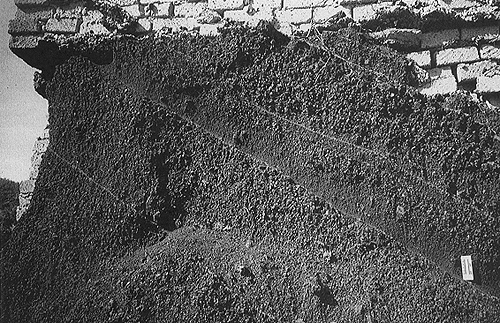
Structureless beds (parallel)
Plate 18

Structureless beds (parallel)
Plate 18
Beds deposited by mass flow processes often lack internal structures and are welded on top of each other. As a result, bedding is barely detectable, and is described as ill-defined; or, you can say that the sediment looks poorly (faintly, crudely) bedded. The attribute "massive" is also used for this case, but should be avoided because it bears some ambiguity: not all "massive"-looking beds are produced by mass flows. Some are accumulated particle by particle (for instance, by fall of isolated stones from a wall).
Plate 18 shows pyroclastic beds made of coarse materials, i.e., cinder and lapilli. Cinder, or scoriae, are pieces of lava ejected from a volcano; they are hot, plastic and solidify soon after falling. At the same time, they weld together. Lapilli are pebble-sized, light and brittle fragments of lava that has already solidified but is rich of vugs (vesicles). Cinder and lapilli are emplaced near volcanic vents by fall or high-density mass flows driven by gravity.
The bedding is made visible here by changes in grain size and especially by the presence of thin drapes of fine ash (light lines).
The lack of structure within a bed can depend on two categories of causes: 1) the mechanism of deposition, and 2) a process occurring after deposition and canceling primary structures; such a process can be mechanical or biological (bioturbation).
In pyroclastic fall deposits, the coarsest particles are found at the base and closer to the vent, because they are heavier and land before the others (and travel shorter distances). In other terms, gravity operates a vertical sorting of clasts during fall, which results in an upward grading . The bed is not graded, it means that the fragments had small differences in size (weight) and fall velocity: one is probably very close to the vent. Most beds in the picture actually have an homogeneous texture.
Vertical grading is accompanied by lateral grading, with the average grain size decreasing away from the source; bed thickness also decreases.
Ejected particles that do not follow individual, ballistic trajectories may have another fate: they are so closely spaced that gravity entrains them in mass flows down the flanks of volcanoes. How can you detect this behavior? Look at the bed where the scale is placed. It displays an inverted grading , with coarser particles at or near the top. This cannot be due to gravity alone, i.e., to free fall. The particles must have moved in mass along a solid surface, bouncing and colliding owing to their high concentration. The effect of collisions within such a flowing layer is to expand the layer itself (you can try to reproduce this effect with Ping Pong balls): the largest particles are pushed farther from the bottom, while the finer ones sieve through them and approach the base of the flow. Mass flows of this type, sort of stony or rock avalanches , can move in a dry state if the slope is steep enough. The effect of water is that of lubricating the movement, whereby wet avalanches can occur on milder slope.
����